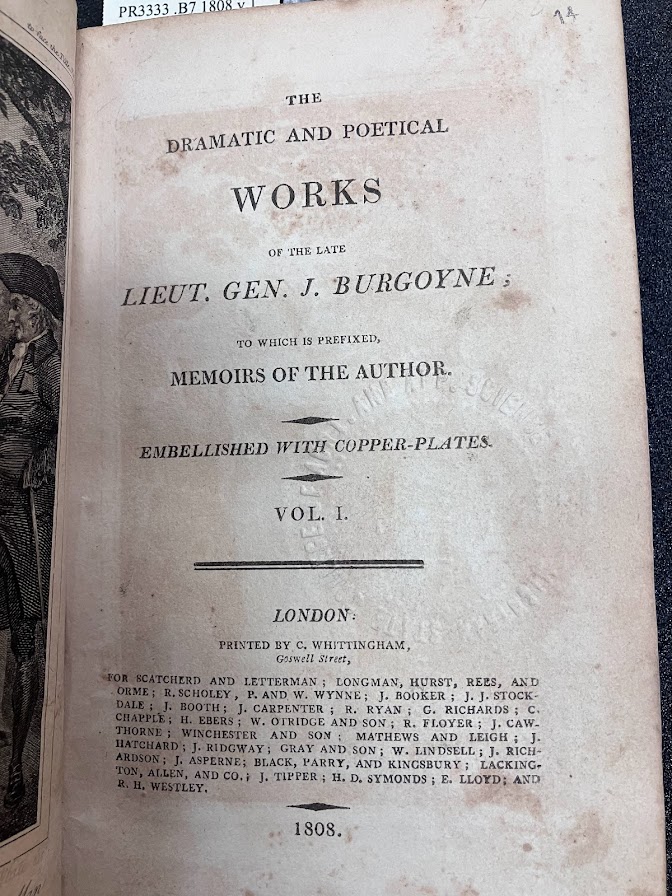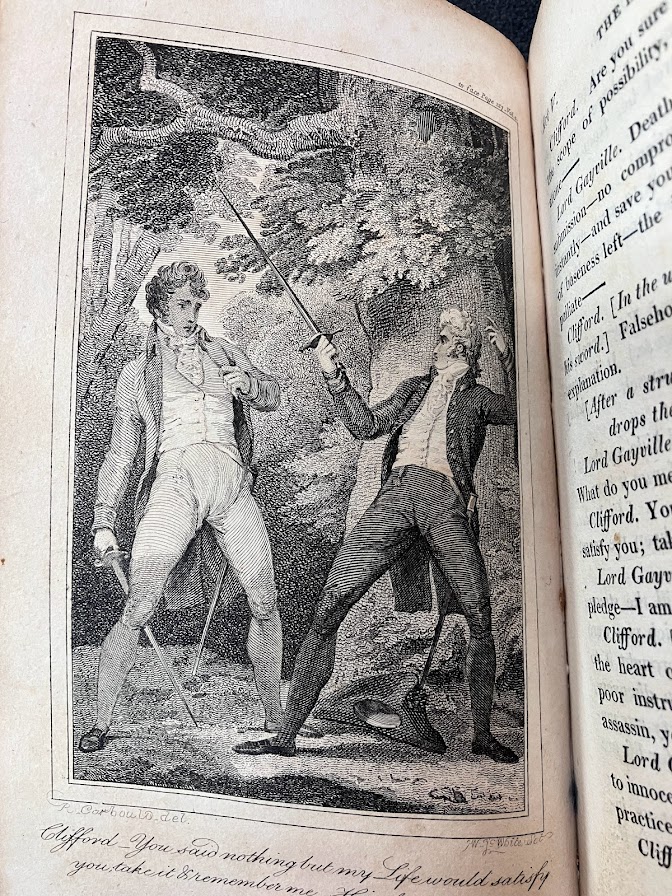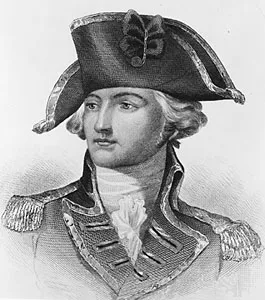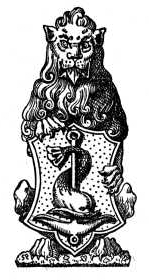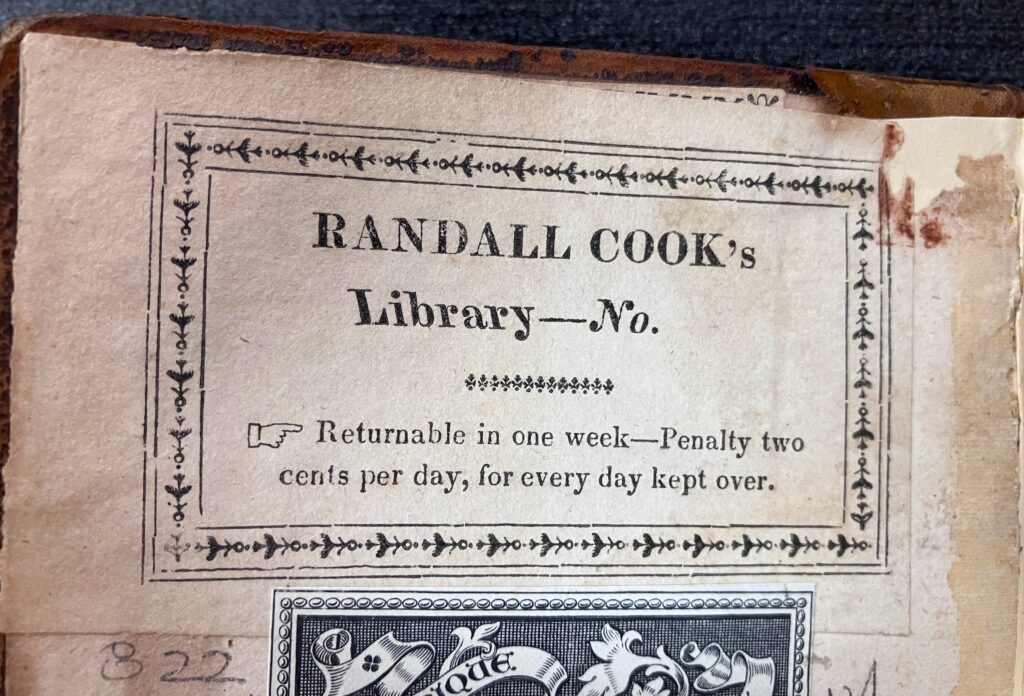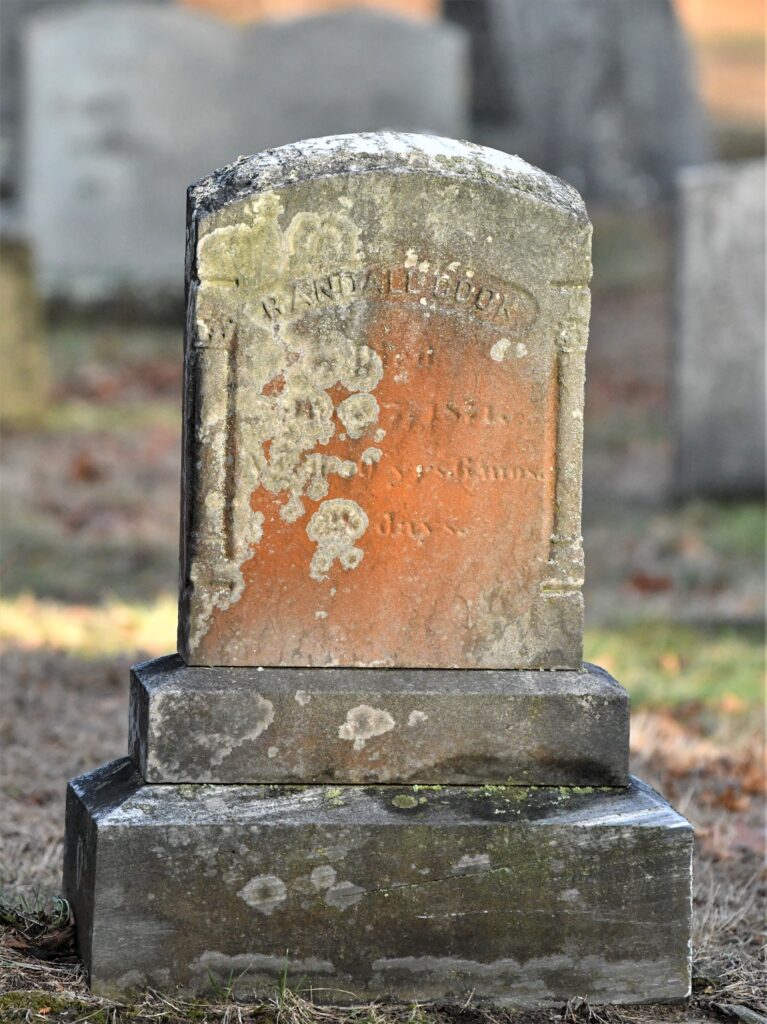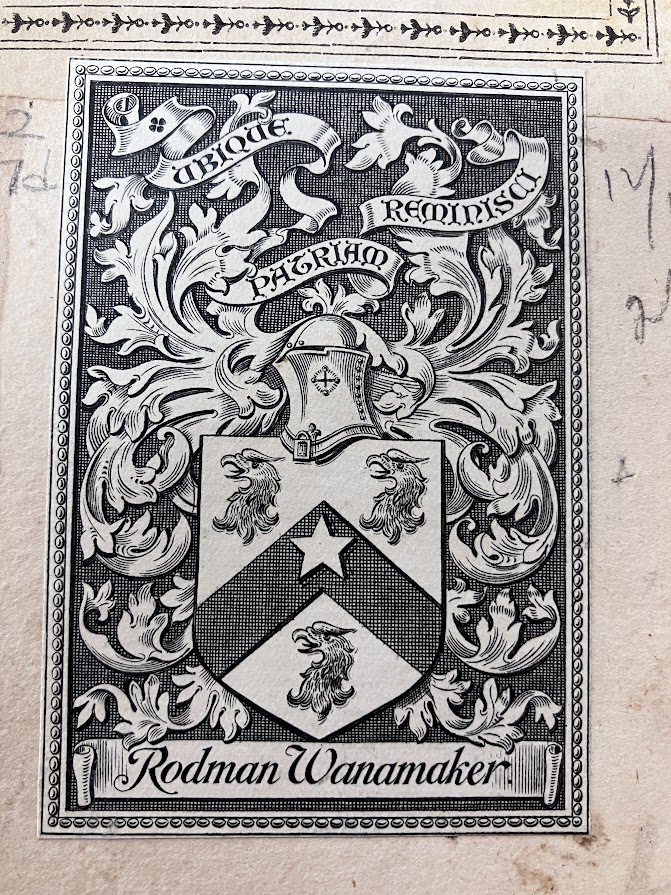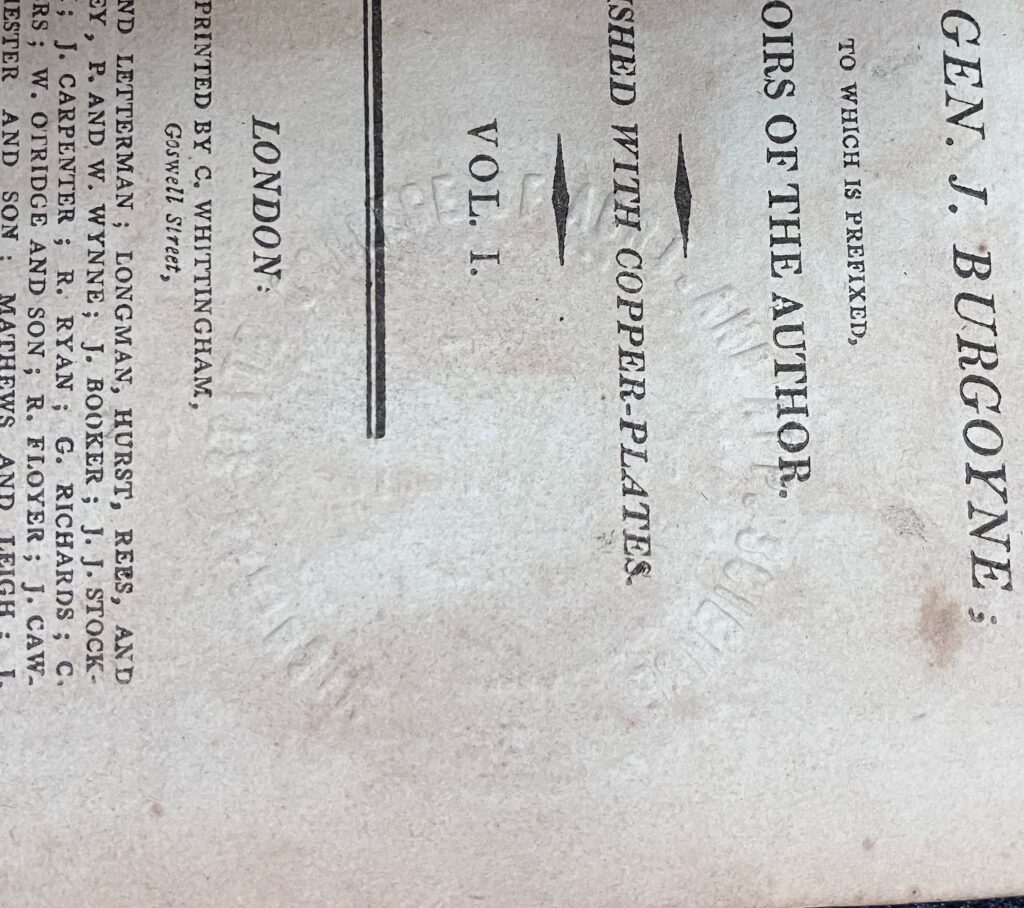Full Title: The Dramatic and Poetical Works of the late Lieut. Gen. J. Burgoyne; to which is prefixed memoirs of the author. Embellished with copper plates. Volumes 1 and 2
Author: General John Burgoyne
Imprint: printed by C. Whittingham, Goswell Street, London 1808
MSU Call Number: PR3333 .B7 1808
About the Books

These two books are a collection of the poetry and plays written by the British General John Burgoyne. Volume one includes a memoir of the author and two plays, while the second includes two more plays and seven poems. Based on the contents of the books, they would likely be owned by someone educated and with moderate wealth. It is also worth noting that the two volumes have remained together since their initial printing and thus have identical provenance.
The first includes 234 numbered pages and the second has 244. They each have multiple detailed copperplate illustrations. Overall, both volumes are in good condition, with no damage or missing pages. Both books have had the spines replaced but are otherwise in good condition.
There are two separate bookplates on the front pastedown of each book, one for “Randall Cook’s Library”, and one for Rodman Wanamaker. There are also some pencil numbers and letters written around the bookplates, in addition to the pencil date written on the contents page, presumably from MSU. MSU also left two stamps in each book from when it was the Michigan State College of Agricultural and Applied Sciences.
Author – General John Burgoyne
John Burgoyne, along with being a British military general, was known for being a dramatist and politician. He lived from February 24th 1722 to August 4th 1792 and played a role in both the Seven Years’ War and the American Revolution. In fact, he may be best known for his defeat by American forces led by General Philip Schuyler and General Horatio Gates in the Saratoga (New York) campaign in 1777.
His most successful play, The Heiress was written in 1786 and is featured in volume two of the Burgoyne Works. However, history appears to remember Burgoyne more for his time in battle than for his poetry. The works were not published until 1808, more than a decade after his death. He is buried in Westminster Abbey in London.
Printer – Charles Whittingham
The Burgoyne works were printed in London in 1808 by Charles Whittingham, who would go on to found Chiswick Press only three years later. Charles lived from 1767 to 1840 and passed the business to his nephew Charles Whittingham II in 1838. Under the younger Whittingham Chiswick Press became influential in both English printing and typography. It remained in operation until 1962, printing books as prestigious as Canterbury Tales and Francis Bacon’s Works.
The title pages also list the many publishers Whittingham printed the Burgoyne Works for. Perhaps the most famous is Scatcherd & Letterman. Hannah Black, Parry, and Kingsbury is notable for being a owned by a woman. Every bookseller or publisher that I could identify was based in London, so the books were almost certainly made their way to the US much later.

Provenance
Randall Cook
Despite pasting his name into both volumes of the Burgoyne works, complete with a penalty for late returns, Randall Cook remains a mysterious figure. It clearly cannot be the American artist and film actor Randall William Cook, as he was not born until 1951, after the books were acquired by MSU. Furthermore, this Randall Cook must have owned the books before Rodman Wanamaker, given the overlap of the bookplates. It’s possible the Cook plates are even covering another previous owner’s plate. There appears to be the border of another paper peaking out along the top edge.
One potential match is a Randall Cook who lived in Massachusetts from 1801 to 1871. He was married to Sarah T Cook and census records show him living in the same area for several decades. According to those same census records he was a dry goods merchant, a relatively lucrative trade in the early and mid 1800’s. With this career he would have had enough money to own a small library. He is buried in Mount Zion Cemetery in Whitman MA and his grave is pictured to the left. This is only one of many Randall Cook’s that could have owned the books. I searched primarily in the New England area, reasoning that at the time it would be unlikely for a single book to travel far across the country, much less two volumes together.
The fact that the bookplate says “Randall Cook’s Library” instead of simply “Randall Cook” suggests that it make have been an institutional rather than private library. I assume Cook is an American since the late fine is in cents as opposed to pence. Disappointingly, no amount of searching for the library of Randall Cook produced any results.
Rodman Wanamaker
Lewis Rodman Wanamaker lived from 1863 to 1928 and was known for, among other things, being heir to the enormous fortune amassed by his father John Wanamaker’s chain of Wanamaker department stores in Philadelphia, New York City, and Paris. The original Philadelphia location was one of the first department stores in the United States.
Rodman was a learned man and known to be a patron of the arts and education. He attended Princeton University, graduating in 1886. Rodman did not become active in his father’s business until the store holdings were passed to him after the elder Wanamaker’s death in 1922. Instead, he was largely content to pursue his own interests in music, aviation, and liturgical arts.
In addition to the Wanamaker department stores he is most notable for originating the idea for the PGA and the Wanamaker expeditions. These expeditions were three trips to photograph Native Americans, ostensibly with the goal of documenting what was perceived as a vanishing culture. In reality, the photographs romanticized Native American life and attempted to assimilate them into white life.
Parke-Bernet Galleries
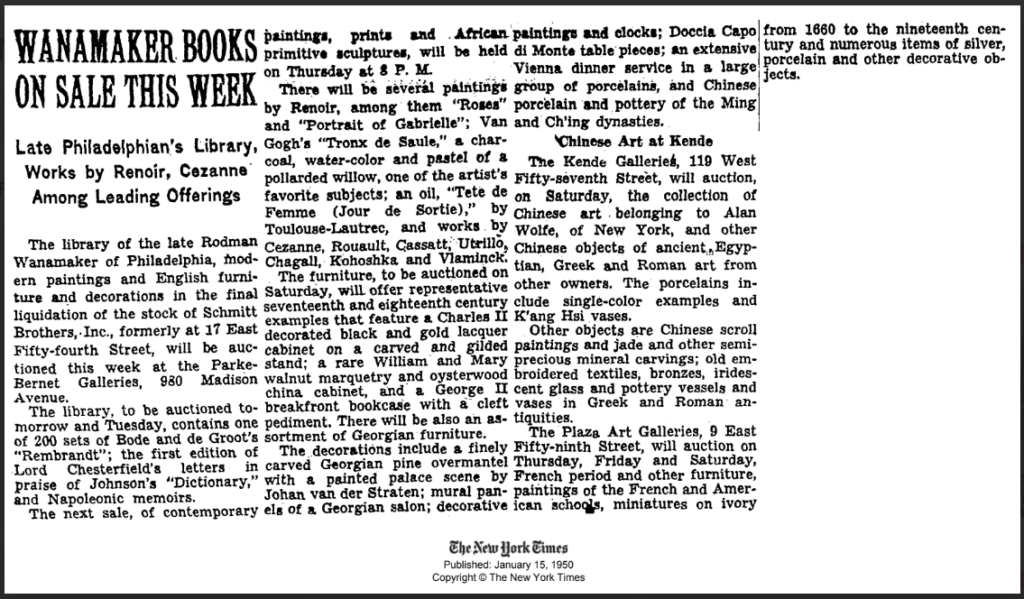
A New York Times article from January of 1950 (pictured to the left) mentions an estate sale for “the late Rodman Wanamaker”, which included his library of between five and six thousand volumes, along with furniture and paintings. The Burgoyne works are not specifically mentioned in the article, but one can assume they were included in the auction. The library sold for a total of $9,489, which would be worth well over $100,000 today. The sale was at the Parke-Bernet Galleries, Inc. 980 Madison Ave in New York City. Although I could not find the books specifically listed in the auction catalog I imagine they were sold with the rest of the estate. However, since the books did not reach MSU until 1952 I believe they were purchased at auction by a bookseller and came to MSU after that.
MSU Special Collections
Ownership
Pencil notes in the volumes indicate that they were acquired by MSU on June 16th 1952, although at the time it would have been known as the Michigan State College of Agricultural and Applied Sciences. This matches the seals stamped onto the title pages and 100th page of each book. In the two year gap between the books going to auction and arriving at MSU they were most likely at a bookseller. Pencil numbers and letters written around the bookplates also suggest that the volumes were at a bookseller at some point in their history. I would presume one in New York City or elsewhere nearby since that is where the auction occurred.
Conservation
A note in the MSU catalog listing for the books mentions the books received some amount of conservation work outside of the university. “Conservation 2017 Wiering Books, Grand Rapids, MI” According to their website, Wiering Books does “historical bookbinding, restoration of books and paper, boxes, and custom work for the discerning collector”. Both volumes have evidently been rebacked, most likely this was done by Wiering Books. Interestingly, a piece of volume two’s original spine was found tucked in the pages about halfway through the book. The number 15 is penciled on the back of the piece, as well as inside volume 2, presumably to keep track of what book the fragment belonged to.
A Rough Timeline
The general path of the books through time begins with their printing in London in 1808 and ends in the MSU special collections. After printing, the books passed to one of the many London based publishers and booksellers listed by the printer. The books somehow made their way from London to the United States to the library of Randall Cook, most likely in the New England area. They were later (somewhere between 1863 and 1928) owned by Rodman Wanamaker in Philidelphia, before being sold with his estate in 1950 by Parke-Bernet Galleries in New York City. They most likely went to a bookseller in NYC before reaching Michigan State College of Agricultural and Applied Sciences in 1952, and then MSU special collections in 1962, where they are today.
By: Elizabeth Longcore for Dr. Brockey’s HST 475 class at MSU Fall 2023
